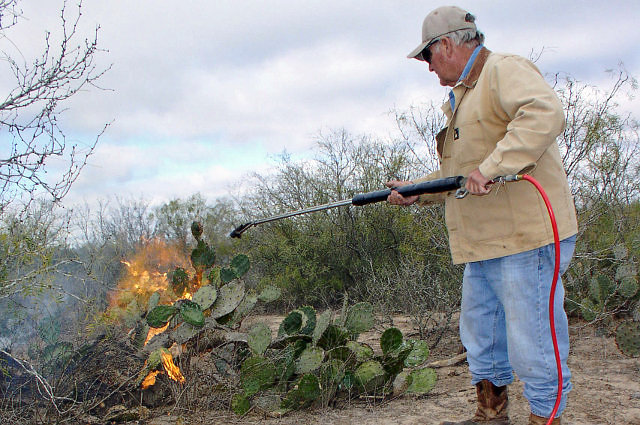Scorching Cactus and Hauling Water, Ranchers Try to Survive Drought

Bill Barfield, a South Texas cattle rancher near the Jim Hogg and Starr County line, burns needles off cactus pads to feed to parched cattle. Photo by Omar Montemayor/AgriLife Extension, used with permission.
By Hannah Jones
For Reporting Texas
One of the state’s worst droughts in decades has been particularly hard on its iconic ranching business, with the barren land leading to increased costs to feed cattle. In Starr County, at the southern tip of the state, Texas Agrilife Extension agent Omar Montemayor can’t give the ranchers money or rain, but he is teaching them ways to keep their herds healthy.
“Ranchers are very frustrated right now, and many of them don’t think there is anything to help them but just rain,” said Montemayor, who runs workshops for ranchers and farmers to help them get through their crisis. “Some have attitudes and will not attend, but the majority of them do.”
Montemayor said that ranchers in Starr County are making the best of harsh circumstances. He said that his programs have had good turnouts recently because ranchers see the benefit. One May workshop will be about testing the nutrition levels of cattle.
Montemayor said the drought is one of the worst that he’s seen in the 19 years he’s been an agent, and it has forced ranchers to make some tough decisions. Cattle prices have risen about 20 percent since 2010. Prices have increased because the state’s cattle inventory has fallen to 4 million, the lowest figure since 1959 and a 12 percent drop over the past two years, according to the Texas Department of Agriculture. Montemayor speculates that the drought has contributed to the low inventory. But ranchers who sell now are likely to have a tough time restocking their herds later because cattle prices are not expected to drop soon.
Ranchers who want to remain in business struggle to feed their cattle. A bale of hay, which can feed 30 cattle for four days, cost $100, more than double the cost in 2009. One of the biggest expenses for ranchers is transporting water to their land. Because many ponds and stock tanks on ranches are dry, Starr County ranchers must purchase and haul water from Rio Grande City. Water costs about $10 for 500 gallons, and the daily trips add labor and diesel costs, and wear and tear on their vehicles.
“If you have to haul water, you might as well put wheels on the cows,” rancher Bill Barfield said.
Barfield, whose ranch is about 150 miles northeast of McAllen in the Wild Horse Desert, said he had 1,000 cattle before the drought. His herd has dwindled to 300.
Like some other ranchers, Barfield has resorted to last-ditch efforts to feed his herd, including chamuscando, a technique that Mexican ranchers have used since the late 1700s, according to Montemayor. Chamuscando, Spanish for “scorching,” involves burning off the needles from prickly pear cactus, so cattle can feed in cactus patches. The cactus pads are low in protein but as long as they aren’t dried up, they are high in vitamins and minerals.
Barfield supplements chamuscando with molasses-based feed. Other ranchers are feeding their cattle with citrus pulp pellets made from oranges from the Rio Grande Valley.
The drought means that ranchers also have to be more diligent about watching their herds. “I used to check on the cattle once a week, but in today’s environment, I’m checking on them every day or every other day to burn pear, doubling or tripling my gas {costs},” Barfield said. “They’re weak, and there’s not much left to them.”
Barfield, 63, said his situation is similar to his father’s back in the 1950s. Barfield, who comes from a family of ranchers who have lived in South Texas for more than 150 years, said that he could remember his father dealing with drought on their ranch in Jim Hogg County. As a child of 3 or 4, Barfield would ride alongside his father around the ranch and watch him work, including burning prickly pear cactus.
He said that if it doesn’t rain soon, he will have to decide what to do with the cattle he has left. “It’s fast becoming back to the Dust Bowl,” he added, referring to the famous drought of the 1930s that parched the Great Plains region.
Montemayor, for one, is looking forward to summer tropical storm season.
“We’re always optimistic,” he said. “We may get the rain here in May and if not, in September.”